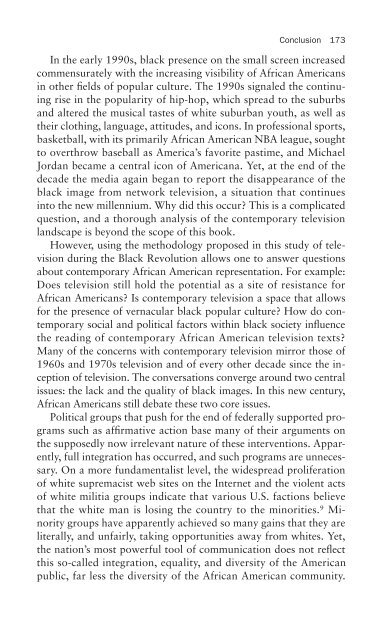Revolution Televised.pdf
Revolution Televised.pdf
Revolution Televised.pdf
Create successful ePaper yourself
Turn your PDF publications into a flip-book with our unique Google optimized e-Paper software.
Conclusion 173<br />
In the early 1990s, black presence on the small screen increased<br />
commensurately with the increasing visibility of African Americans<br />
in other fields of popular culture. The 1990s signaled the continuing<br />
rise in the popularity of hip-hop, which spread to the suburbs<br />
and altered the musical tastes of white suburban youth, as well as<br />
their clothing, language, attitudes, and icons. In professional sports,<br />
basketball, with its primarily African American NBA league, sought<br />
to overthrow baseball as America’s favorite pastime, and Michael<br />
Jordan became a central icon of Americana. Yet, at the end of the<br />
decade the media again began to report the disappearance of the<br />
black image from network television, a situation that continues<br />
into the new millennium. Why did this occur? This is a complicated<br />
question, and a thorough analysis of the contemporary television<br />
landscape is beyond the scope of this book.<br />
However, using the methodology proposed in this study of television<br />
during the Black <strong>Revolution</strong> allows one to answer questions<br />
about contemporary African American representation. For example:<br />
Does television still hold the potential as a site of resistance for<br />
African Americans? Is contemporary television a space that allows<br />
for the presence of vernacular black popular culture? How do contemporary<br />
social and political factors within black society influence<br />
the reading of contemporary African American television texts?<br />
Many of the concerns with contemporary television mirror those of<br />
1960s and 1970s television and of every other decade since the inception<br />
of television. The conversations converge around two central<br />
issues: the lack and the quality of black images. In this new century,<br />
African Americans still debate these two core issues.<br />
Political groups that push for the end of federally supported programs<br />
such as affirmative action base many of their arguments on<br />
the supposedly now irrelevant nature of these interventions. Apparently,<br />
full integration has occurred, and such programs are unnecessary.<br />
On a more fundamentalist level, the widespread proliferation<br />
of white supremacist web sites on the Internet and the violent acts<br />
of white militia groups indicate that various U.S. factions believe<br />
that the white man is losing the country to the minorities. 9 Minority<br />
groups have apparently achieved so many gains that they are<br />
literally, and unfairly, taking opportunities away from whites. Yet,<br />
the nation’s most powerful tool of communication does not reflect<br />
this so-called integration, equality, and diversity of the American<br />
public, far less the diversity of the African American community.

















